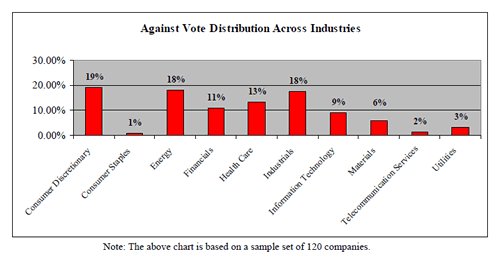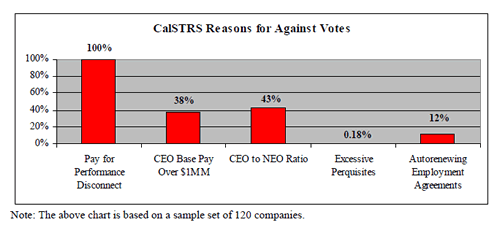Anne Sheehan is Director of Corporate Governance at the California State Teachers’ Retirement System.
One thing is for certain: Pay is unique at every company. There are as many iterations of pay as there are companies in America. This uniqueness makes our job as shareholders very challenging. For the most part, we must rely on the members of compensation committees to develop the compensation philosophy and structure in order to incentivize management and align their interests with those of shareholders. We believe that poorly structured pay packages harm shareholder value by unfairly enriching executives at the expense of owners – the shareholders. On the other hand, a well aligned compensation package motivates executives to perform at their best. This benefits all shareholders.
There have been many changes this proxy season and although the evaluation of compensation is still a challenge, we have learned a few things along the way. Given the unique nature of compensation, CalSTRS tried to evaluate pay holistically at every company. We not only looked at the alignment between pay practices and the performance of the companies, but also corporate peer groups, problematic pay practices, and disclosures.
CalSTRS Facts:


A Look Back on 2011
Pay-for-Performance Disconnect the Overwhelming Reason for Against Votes
The overriding tenet of any well designed compensation plan should be a link between executive pay and company performance. We believe performance goals should be disclosed and performance hurdles should be meaningful to drive long-term shareholder value.
CalSTRS predominantly voted against companies’ Say-on-Pay proposals because of disconnects between pay and performance. In most cases, the companies we voted against had negative 5-year performance numbers when viewed on an absolute basis. As a long-term permanent investor we are very focused on long-term total shareholder returns and in many cases companies were initially targeted because of their 5-year performance figures. CalSTRS next examined the companies’ one- and three-year performance figures on a relative basis against their peers. In some cases, there was overpayment for good performance, and in other instances overpayment for poor performance.
Below are some statistics based on market capitalization of the companies where CalSTRS voted against the Say-on-Pay.

Predominant Use of Board Discretion
CalSTRS believes that all companies should use value-creating performance metrics for short- and long-term incentive plans. While we understand that boards of directors require some flexibility when determining compensation, we believe the majority of executives’ incentive pay should be transparent and easily understood by shareholders. Although there is no one-size-fits-all solution to executive compensation, we believe the over-use of discretion in most plans can lead to outsized compensation levels and fails to meet the spirit of section 162(m) if the Internal Revenue Code which requires performance-based pay to be predetermined and objectively measurable.
In general, most firms still provide a laundry list of performance metrics to account for the compensation paid, which appear to give discretion to compensation committees to choose which of these metrics are used. It was rare that committees even provided commentary as to how the metrics were prioritized when evaluating performance. CalSTRS does not believe it is the shareholders responsibility to determine the appropriate metrics to use; this is a primary responsibility of the compensation committee. Compensation committees must be able to articulate to shareholders which metrics they believe are ultimate value drivers for their businesses and describe how those metrics were used to determine compensation levels.
Peer Selection Remains a Challenge
CalSTRS understands the challenges companies face when selecting a peer group and that peer groups are entwined with performance measurement and compensation. The lack of a widely accepted standard to establish peer groups makes this doubly complicated as shareholders naturally prefer an established benchmark that is not susceptible to potential biased-selection by management.
Similar to the differences among compensation practices, there are as many different ways in which companies develop and use peer groups. We found that this practice led to a variety of problems. In some cases, companies fail to adequately disclose their rationale for selecting a particular peer or set of peers. In other cases, the justification is unacceptable because the number of companies in the group is too large, the sheer size of the companies is mismatched, or the peers are in an unrelated industry. Some of these deficiencies can be remedied with further disclosure. In other cases, companies appear to be outliers when compared to other companies of similar size and within the same industry.
Challenges for next year include determining how shareholders can quickly and efficiently identify a comparable peer group when analyzing a company and how to know if the peer group chosen by the company is appropriate. As with many of the issues shareholders faced this season, problems with peer groups can be addressed with more thorough disclosure, especially related to changes in a company’s peer group or when company peers are materially different than standardized industry peers.
Eliminate Questionable Pay Practices
Negative vote recommendations often stemmed from “problematic pay practices” such as tax gross-ups, excessive perquisites, supplemental executive retirement benefits, and severance pay. CalSTRS believes that such practices do not belong in a thoughtful well-designed performance driven compensation program.
The elimination of tax-gross ups is definitely seen as a best practice in corporate governance as companies continue to eliminate tax gross-ups or prohibit tax gross-ups in future contracts. The value of key perquisites also trended downward as only 21 companies in the sample provided perquisites of $250,000 or more (see chart below titled, CalSTRS Reasons for Against Votes).
Pay Equity in the C-Suite
Since the enactment of Dodd-Frank, there have been discussions about various pay ratios, often referred to as internal pay equity. CalSTRS understands that companies operate under various business models and their use of employee capital is deployed differently. This being said, we do think the pay ratio at the top of an organization gives some insight into the workings of the board. CalSTRS found that on average most companies had a CEO pay to NEO (Named Executive Officers) pay ratio of two to three times. A ratio over 3 causes us to question the board’s succession plan, the internal culture of the company, and the CEO’s influence over the board.
Several companies in our sample set had CEO to NEO ratios over 3 and although we would never vote against a company’s say-on-pay for this factor alone, it was often coupled with other problematic pay practices.
The chart below illustrates the major reasons why CalSTRS cast a vote against companies’ Say-on-Pay proposals. As evident in the chart, CalSTRS primary reason for voting against was due to the pay-for-performance disconnect.

Looking Ahead to 2012
Proxy Statements are Still Unclear
The proxy-statement discussion describing executive compensation programs is largely too complex and lengthy for the average investor. The complexity of these statements is largely driven by mandatory legal rules that make the narratives too long, too complex, and full of legal jargon. Many companies this year provided short and simple executive summaries which described in “plain English” the companies’ approach to compensation. We believe shareholders will see an increase use of executive summaries in the years to come.
Ratcheting Up of Pay Continues
Several companies this year continued to use their peer group as a way to establish target compensation. Although peer groups can be a helpful check to determine if the internal structure and policy setting of pay is reasonable and competitive, peers should not be the starting point when structuring pay. CalSTRS found it especially troubling when companies targeted pay above the median, particularly when companies targeted the 75th or 90th percentile. When pay is initially targeted at these above-average levels it sets the base pay at above-average levels. As a consequence we saw companies over paying for on-par or below-average performance.
These types of pay setting structures will be a renewed focus for CalSTRS next year.
The Summary Compensation Table vs. Realized Pay
There continues to be a debate around compensation figures disclosed in the Total Summary Compensation (TSC) Tables and what executives actually take home in pay. For equity compensation, the current required disclosures in summary compensation tables are based on Black-Scholes calculations. The Black-Scholes calculation is the standard model used to determine the fair price of financial instruments, such as stock options, but is based on assumptions of a company’s stock price volatility, time to expiration, and strike price of the option. These figures disclosed in the compensation tables are as much a way to incentivize executives going forward as a reward for past performance. Of course, if the compensation committees have fulfilled their responsibilities these figures will align with the company’s performance when observed in the future. Unfortunately, when shareholders are casting a vote on say-on-pay they are forced to use the information most readily available which includes the summary compensation table and past performance.
In the future, CalSTRS hopes we will see more companies include additional tables which describe pay that was actually realized by the executives in an effort to demonstrate a better alignment. In the end, you can’t take Black-Scholes to the bank. As a long-term shareholder, reviewing thousands of proxies each year, we believe it is important for issuers to provide data that is easily understood by shareholders and can be compared across companies and industries. CalSTRS believes there is an opportunity for the marketplace, issuers and shareholders, to work together in the development of a realized pay model. After all, without standardized models and calculations these types of figures would only add complexity to what is already a very cumbersome process.
Summary
For CalSTRS the first year of Say-on-Pay was a learning opportunity as it helped us to refine our voting process for future years. In the end, we managed to vote all of our proxies in a timely manner while continuing to apply the same diligence and care to our proxy votes as in years past. We look forward to continued engagement with the companies in which we invest as we work together to truly align compensation with the interests of all market participants.
 Print
Print
2 Trackbacks
Second Time Around on Say-on-Pay…
The advisory shareholder vote required under the Dodd Frank Act went through its first cycle in 2011, and by and large most companies’ shareholders approved the companies’ executive compensation plans. Only about 45 companies (less than 2%)…
[…] and Financial Regulation entitled “Lessons Learned: The Inaugural Year of Say-on-Pay” (here), Anne Sheehan, the Director of Corporate Governance at the California State Teachers’ […]